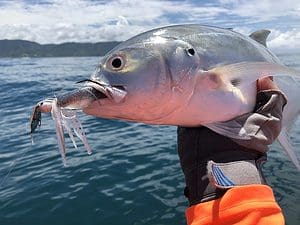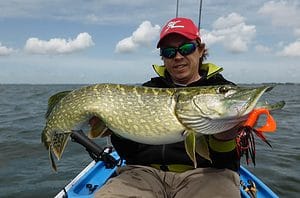Disclosure: Some posts contain affiliate links, which earn us a commission if you make a purchase through them. Positive Fishing © participates in various affiliate networks including the Amazon Services LLC Associates Program.
If you have never cast out a chatterbait or are not even sure what one is, you are missing out, as these lures are extremely effective at catching bass, especially when no others are working.
Quite a few bass anglers out there might have one or two in their boxes, but knowing how to fish with them correctly is also key to greater bass catching success.
You can simply cast one out and wind it in and catch a fish or two, but if you want to catch fish all day, you need to learn how and when to fish a chatterbait properly.
Join me as I run through everything you need to know about when and how to fish a chatterbait so that you can pin as many bass in a day on the water as possible.
What Is A Chatterbait?
A chatterbait is essentially a weighted jig head with a skirt with the addition of a large hexagonal blade at the front of it. This blade takes the skirted jig to another level as it adds a ton of vibration, aka noise, in the water, which curious bass can not help but take a look at.
They don’t always come as a jig head with a skirt either, you can also find soft plastic chatterbaits which have a large hexagonal blade at the front to attract fish from long distances.
What Types Of Chatterbaits Are There?
Chatterbaits can come as either a jig head with a skirt and hexagonal blade, soft plastic with a hexagonal blade, or a combination of the two – a jig head with a skirt, soft plastic, and blade.
You can also find them in different weights ranging from 3/8 oz to 1 oz, and choosing the right weight chatterbait depends on what depth you would like to fish at.
How Do Chatterbaits Work?
The reason chatterbaits are so good at attracting bass and other predatory species is because they make a lot of noise, but how?
When you bring in a chatterbait the large hexagonal blade bounces off the jig head with every pull, “chattering away” as you bring the lure back from a cast.
This constant chattering is very loud to fish, and it can also displace water and create surface turbulence when fished shallow, attracting fish.
When you combine the chattering of the blade with a jig head or soft plastic, which are already very effective lures, you get a deadly combination that catches fish.
What Fish Can I Catch With A Chatterbait?

fish such as this Jack Cravelle
Bass is always the most popular target fish when using chatterbaits. However, other predators, such as pike and musky, are often caught using a variety of these lures.
It is also a very effective method for catching saltwater fish such as Jack crevalle and snapper.
How To Fish A Chatterbait?
There are numerous ways to fish a chatterbait, depending on the situation you find yourself in. It always pays to mix it up a bit and experiment with all the methods below to see which method works best.
Fish Chatterbaits Slowly
The first key to success when fishing a chatterbait is fishing it slowly. These are not lures that you simply cast out and wind back as fast as you can, they are designed to attract fish while being moved slowly across a rock pile or around weeds for example.
It’s important to go slow and let it do its thing, and you have to believe it will catch a fish and trust the lure. But, you also need to work chatterbaits correctly, and here is how.
Pop & Drop Technique
This technique has your lure being fished close to the bottom, creating a rising and falling motion that bass love to attack. Here is how you do it:
- Cast your chatterbait into a fishy spot
- Let it sink to the bottom
- Lift your rod, pulling the chatterbait off the bottom
- Wind in the slackline
- Let the chatterbait drop again
- Repeat
Make sure to lift your rod with a sharp pump to get the lure moving so that the skirt, soft plastic, and blade are doing what they are supposed to. As it rises, it’ll make a lot of noise; then, as it drops, it creates a pause for the bass to strike and change depths.
Slow & Steady
This is probably the easiest way to fish a chatterbait. It is highly effective when you want to fish above some cover like a weed bed, as it sits right above it without snagging and tempts the fish out from their lairs. Here is how to do it:
- Cast your chatterbait out over some cover like a weed bed
- Begin a very slow and steady retrieve
- If you snag the weeds, speed up a little
- If the chatterbait is too high in the water, slow down
- Make sure it’s as close to the cover as it can be
- Continue winding slowly, letting the bait chatter away while the skirt/soft plastic does its thing
- A bite should be imminent
You can imagine a chatterbait noisily going over a brush pile and driving bass crazy – this is a super effective method.
Chatterbaits On The Bottom – Hopping
Bottom hopping is pretty much jigging your lure along the bottom from one spot to the next. As the chatterbait rises and falls while coming closer to you, it creates a rising and falling action that is something bass can’t resist. This is how you do it:
- Cast your chatterbait out
- Let it sink to the bottom
- Lift your rod with a short, sharp pump
- Wind in the slackline
- Let the chatterbait sink to the bottom again
- Repeat
This is a very effective method to use when the bass are holding deep when the weather is either too hot or too cold. Make sure to fish this slowly, as when bass are holding deep, they also lack energy and want an easy meal.
When Should I Use A Chatterbait?
As is the case with all lures, chatterbaits have a time and a place when they should be used and will be more effective than other baits. Here is when to cast a chatterbait.
Weeds & Grass
Chatterbaits are actually built to pull through vegetation and, therefore, will not get snagged easily. They are, therefore, ideal for fishing around grassy and weedy areas as you can get super close to where the bass are lurking.
You usually want to find a grass or weed bed around 1 to 6 feet deep, but make sure it’s not too dense. If it’s super dense, then the bass can’t hide in it, and even your lure will get snagged.
Fallen Wood
Bass love to hide around fallen trees, roots, and brush piles, and the great thing about chatterbaits is that you can get the lure right amongst them. The key to fishing wood piles correctly is feeling the lure and working it right next to the structure without actually snagging it.
This takes some time to master but when you do, you’ll be hooking bass left, right, and center. Just be sure to move it up as soon as you feel it touch the wood.
Around Docks
Docks always hold baitfish, especially if they have any weed around them, and chatter baits are deadly when fished under them. The wonderful thing about a chatterbait is that you can skip it across the water, meaning you can slide it right under a dock.
Admittedly, being able to skip a lure when you cast will take some practice if you’re not a pro, but it is worth putting the time in to learn.
Mussel Beds
Bass love to hang out around mussel beds during the summertime, and the great thing about a chatterbait is that you can slowly work it along the bottom amongst the mussels on the bottom.
This puts your chatterbait right in the strike zone, and you’ll often find that it’s the biggest bass of them all that eats the lure.
In Dirty Water
When the water is dirty, they come into their own and are more effective than most other lures simply because they make a lot of noise. If you combine it with bright colors like chartreuse and white, you have a lure that bass can easily find amongst the dirty water.
When Fish Go Deep
The great thing about a chatterbait is that you can fish it right on the bottom if you want to, and this is ideal when the bass goes deep. During extremely high or low temperatures, bass will go deep to find warmer or colder water, depending on the season.
Getting your bait down to the bass and keeping it in the strike zone is the only way you are going to catch fish in these conditions, and they make that very easy. Just use the bottom hopping method we went through above; fish slowly, and you will hook up.
Chatterbaits vs Spinnerbaits?

Chatterbait is the most effective around the grass areas or when fishing with limited visibility and wind. Spinnerbaits have more than one hook, therefore it is more difficult to get them through the grassy areas as easy as a chatterbait.
Basically, you will have less frustration and fewer lost lures!
It is just before the spawning stage that they can be the best choice to use; remember, the grass will hold the fish in abundance during this period.
Chatting Up
Thanks very much for reading my article. I hope you learned something about how to fish chatterbaits and are now ready to go out and try all the different techniques. They are such effective lures when fished properly – just remember to go slow, be patient, and trust the lure will work.
Please check out my article on how to fish a jerkbait, and many more bass-related bait and lure options to increase your catch rate success.
- Top Tips For Fishing With Feathers - January 15, 2025
- How To Fish For Flounders: Tips, Rigs, & Baits - March 27, 2024
- Fortis Wraps Fishing Sunglasses: The Affordable Option For Anglers - January 25, 2024


